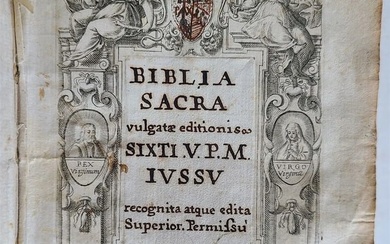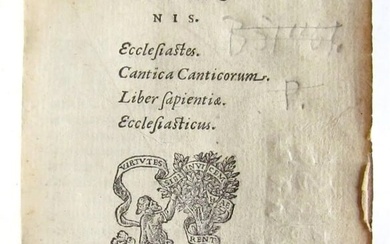Ɵ Bible, in Latin, in Carolingian minuscule, manuscript on parchment [France, 9th century]
Ɵ Bifolium from a Bible, most probably a grand pandect, with Proverbs 30:23-31:31 and Ecclesiastes 1:1-7:20, in Latin, in early Carolingian minuscule, in close derivative of Tours script, manuscript on parchment[western France, second half of the ninth century] Two conjoined leaves, each leaf with double column of 50 lines in Carolingian minuscule showing Tours influence with a 't' whose topline curves back towards the baseline when this character opens words, and a 'g' with a closed bowl and a lean towards the left, an ampersand used for 'et' integrally within words, somewhat cramped and provincial in execution with inelegant letterforms in which the scribe falls back onto cursive letterforms and the letters of "Verba" following its initial apparently forgotten and squeezed into space between words, simple brown initials set off in margins, versal numbers in Roman numerals in margins, important words such as "Aleph" and opening lines of major text sections in ornamental capitals, elegant 3-line initial in red, recovered from a binding and so with holes, tears to edges, folds and stains, legible on inside of bifolium, somewhat scuffed on outer side (but mostly legible), overall fair and presentable condition, each leaf 402 by 320mm.; in cloth-covered card binding, with letter of Prof. Bernard Bischoff concerning this fragment as well as Bernard Rosenthal's cataloguing A bifolium from a grand Carolingian Bible, most probably copying a Tours Bible in a West Frankish scriptorium Provenance:1. Most probably written in a provincial West Frankish centre under the influence of Tours and the Carolingian script reforms there (see below). The format of the leaves strongly suggests that our scribe was copying from a grand Tours Bible (see below), but his frequent lapses into cursive letterforms (see the 'e' in "operient" on fol. 1r, col. 2, line 42), suggest that they were more accustomed to writing charters rather than texts such as this. Discarded at the close of Middle Ages and this bifolium reused on the binding of a copy of Serlio's Architettura: inscription on outer side.2. Lawrence Witten (1926-1995) of New Haven, CT, USA.3. Bernard Rosenthal (1920-2017), San Francisco, CA, his I/247, purchased August 1981.4. Quaritch cat. 1147, Bookhands of the Middle Ages V, 1991, no. 6.5. Schøyen Collection, London and Oslo, their MS 619, acquired from Quaritch in June 1990. Text and script:Following Charlemagne's coming to political power in the 780s in Germany, France and Italy, he turned his attention to the building of an intellectual bedrock on which Europe could refound a common culture as the rightful descendent of the Western Roman Empire. As early as 789, in his Admontio Generalis, he called for the protection of surviving manuscripts of the Bible and ordered that only trusted and mature scribes be allowed to copy them. Following this, he seems to have engaged a number of his court scholars to produce revised and cleaned up copies of the Bible. The copy produced by the grand scholar Alcuin (739-804, from 796 abbot of St. Martin's, Tours) had the advantage of being copied in an entirely new form of script: Carolingian minuscule, created for ease of reading. As Alcuin himself records in a letter to his eventual successor, Fridugisius, the final copy was to be delivered to Charlemagne himself on Christmas Day in 800, the same day as his imperial coronation in Rome (F.L. Ganshof, in Bibliothèque d'Humanisme et Renaissance, 9, 1947, pp. 7-20). These Bibles were then mass-copied in Tours (perhaps as many as several a year for at least half a century) and distributed as apparent imperial gifts across Europe, carrying with them the new script. As studied by David Ganz, the classic Tours pandects were produced according to a rigid template, were consistently written on approximately 450 leaves, and have an overall leaf size of c. 480-375mm. with text in double column and with a solidly consistent 50-52 lines per column ('Mass Production of Early Medieval Manuscripts, The Carolingian Bible from Tours', in R. Gameson, ed., The Early Medieval Bible, Its Production, Decoration and Use, 1994, p. 61). Our bifolium is slightly smaller in format and was written by a provincial hand, but has the correct number of lines and a comparably grand layout to Tours examples. In 1990, Prof. Rosamund McKitterick deduced that this fragment was an "interesting example of the continuing response to the need for a correct text of the Bible", suggesting that its "relatively late date and the independent production may indicate ... that the dominance of Tours of the market was by this time waning" ('Carolingian Book Production', p. 31). The second leaf here contains the famous reading of Ecclesiastes 3: "To every thing there is a season, and a time to every purpose under the heaven: A time to be born, and a time to die; a time to plant, and a time to pluck up that which is planted ...". Published:R. McKitterick, 'Carolingian Book Production: Some Problems', The Library, 6th series, XII (1990).
[ translate ]View it on
Estimate
Time, Location
Auction House
Ɵ Bifolium from a Bible, most probably a grand pandect, with Proverbs 30:23-31:31 and Ecclesiastes 1:1-7:20, in Latin, in early Carolingian minuscule, in close derivative of Tours script, manuscript on parchment[western France, second half of the ninth century] Two conjoined leaves, each leaf with double column of 50 lines in Carolingian minuscule showing Tours influence with a 't' whose topline curves back towards the baseline when this character opens words, and a 'g' with a closed bowl and a lean towards the left, an ampersand used for 'et' integrally within words, somewhat cramped and provincial in execution with inelegant letterforms in which the scribe falls back onto cursive letterforms and the letters of "Verba" following its initial apparently forgotten and squeezed into space between words, simple brown initials set off in margins, versal numbers in Roman numerals in margins, important words such as "Aleph" and opening lines of major text sections in ornamental capitals, elegant 3-line initial in red, recovered from a binding and so with holes, tears to edges, folds and stains, legible on inside of bifolium, somewhat scuffed on outer side (but mostly legible), overall fair and presentable condition, each leaf 402 by 320mm.; in cloth-covered card binding, with letter of Prof. Bernard Bischoff concerning this fragment as well as Bernard Rosenthal's cataloguing A bifolium from a grand Carolingian Bible, most probably copying a Tours Bible in a West Frankish scriptorium Provenance:1. Most probably written in a provincial West Frankish centre under the influence of Tours and the Carolingian script reforms there (see below). The format of the leaves strongly suggests that our scribe was copying from a grand Tours Bible (see below), but his frequent lapses into cursive letterforms (see the 'e' in "operient" on fol. 1r, col. 2, line 42), suggest that they were more accustomed to writing charters rather than texts such as this. Discarded at the close of Middle Ages and this bifolium reused on the binding of a copy of Serlio's Architettura: inscription on outer side.2. Lawrence Witten (1926-1995) of New Haven, CT, USA.3. Bernard Rosenthal (1920-2017), San Francisco, CA, his I/247, purchased August 1981.4. Quaritch cat. 1147, Bookhands of the Middle Ages V, 1991, no. 6.5. Schøyen Collection, London and Oslo, their MS 619, acquired from Quaritch in June 1990. Text and script:Following Charlemagne's coming to political power in the 780s in Germany, France and Italy, he turned his attention to the building of an intellectual bedrock on which Europe could refound a common culture as the rightful descendent of the Western Roman Empire. As early as 789, in his Admontio Generalis, he called for the protection of surviving manuscripts of the Bible and ordered that only trusted and mature scribes be allowed to copy them. Following this, he seems to have engaged a number of his court scholars to produce revised and cleaned up copies of the Bible. The copy produced by the grand scholar Alcuin (739-804, from 796 abbot of St. Martin's, Tours) had the advantage of being copied in an entirely new form of script: Carolingian minuscule, created for ease of reading. As Alcuin himself records in a letter to his eventual successor, Fridugisius, the final copy was to be delivered to Charlemagne himself on Christmas Day in 800, the same day as his imperial coronation in Rome (F.L. Ganshof, in Bibliothèque d'Humanisme et Renaissance, 9, 1947, pp. 7-20). These Bibles were then mass-copied in Tours (perhaps as many as several a year for at least half a century) and distributed as apparent imperial gifts across Europe, carrying with them the new script. As studied by David Ganz, the classic Tours pandects were produced according to a rigid template, were consistently written on approximately 450 leaves, and have an overall leaf size of c. 480-375mm. with text in double column and with a solidly consistent 50-52 lines per column ('Mass Production of Early Medieval Manuscripts, The Carolingian Bible from Tours', in R. Gameson, ed., The Early Medieval Bible, Its Production, Decoration and Use, 1994, p. 61). Our bifolium is slightly smaller in format and was written by a provincial hand, but has the correct number of lines and a comparably grand layout to Tours examples. In 1990, Prof. Rosamund McKitterick deduced that this fragment was an "interesting example of the continuing response to the need for a correct text of the Bible", suggesting that its "relatively late date and the independent production may indicate ... that the dominance of Tours of the market was by this time waning" ('Carolingian Book Production', p. 31). The second leaf here contains the famous reading of Ecclesiastes 3: "To every thing there is a season, and a time to every purpose under the heaven: A time to be born, and a time to die; a time to plant, and a time to pluck up that which is planted ...". Published:R. McKitterick, 'Carolingian Book Production: Some Problems', The Library, 6th series, XII (1990).
[ translate ]![Ɵ Bible, in Latin, in Carolingian minuscule, manuscript on parchment [France, 9th century] Ɵ Bible, in Latin, in Carolingian minuscule, manuscript on parchment [France, 9th century]](https://gcp-la8-storage-cdn.lot-art.com/public/upl/27/Bible-in-Latin-in-Carolingian-minuscule-manuscript-on-parchment-France-9th-century_1591172740_9242.jpg)

![[Bible]. Biblia Sacra Vulgate editionis,... - Lot 226 - Richard Maison de ventes [Bible]. Biblia Sacra Vulgate editionis,... - Lot 226 - Richard Maison de ventes](https://gcp-la8-storage-cdn.lot-art.com/public/upl/26/Bible-Biblia-Sacra-Vulgate-editionis-Lot-226-Richard-Maison-de-ventes_6626e93eaf013-thumb-21862400_1713826111-6626e93f3560f.jpg)




